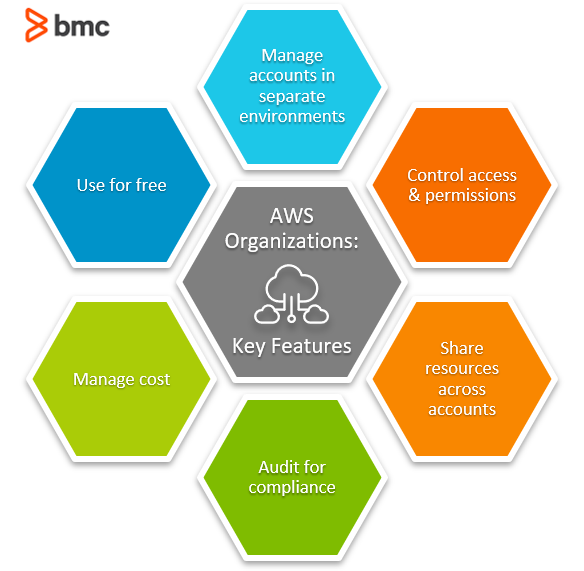AWS Organizations is an AWS account management service that lets users centrally manage and control groups of AWS accounts, and the workflows and policies that apply to them.
The management process can be done manually or programmatically at the API level. Users can:
- Integrate multiple AWS services with multiple unique AWS accounts.
- Manage the user environments based on organizational, legal, or project-based policies.
The accounts can also share resources, security mechanisms, audit requirements, configurations, and policies between multiple AWS organizations.
In this article, we will give an overview of the AWS Organization service and how you can use it as a best practice for your AWS user environments.
(This article is part of our AWS Guide. Use the right-hand menu to navigate.)
User accounts in AWS Organizations
Originally, Amazon Web Services began with a single user account that enrolled multiple AWS services. Each person used a single AWS account and subscribed to multiple AWS services as necessary.
However, using a single account per user limits how organizations can manage the services, security permissions, audits, policies, and billings across multiple business divisions and projects assigned to the same user account.
The concept of AWS account has evolved significantly since the inception of the AWS cloud service, which continues to grow, particularly in the areas of:
- Solutions
- Resource options
- Billing
- Configuration features
Now, we can consider AWS accounts as containers that consist of such capabilities, all governed and managed across multiple AWS accounts but within the same centralized environment.
(Explore other AWS management tools.)
Benefits of AWS Organizations
What are the benefits of using AWS organizations? Here’s why it makes sense to use multiple AWS accounts for the same categories of AWS resources contained in multiple unique and manageable account environments:
- Easily categorize and discover services. Find and assign AWS applications programmatically using APIs, command line interface (CLI), and GUIs.
- Apply logical boundaries to all aspects of policies. Different projects within the organization may be exposed to different security and compliance requirements. For example, by segregating AWS resources within multiple AWS accounts across all of those different projects, you can easily enforce unique identity policies in compliance to the applicable regulatory frameworks.
- Contain damage within logically isolated user accounts. If a specific user account is compromised, only the resources assigned to that AWS Organizations user account will be exposed to the higher risk.
- Easily manage billing and resources on a project or task basis. Employees can switch between their AWS Organizations accounts assigned to them and utilize resources optimally as required.

Key features of AWS Organizations
The AWS Organizations is a service that enables organizations to define, manage, and govern groups of AWS user accounts and centrally provision services and policies—and maintain a single bill for the AWS Organization and the set of underlying user accounts.
To realize these capabilities, AWS Organizations lets you:
- Manage multiple AWS Accounts in separate environments. Establish boundaries that define the policies, services, and resources used across grouped organizational units (OUs).
- Control access & permissions. Enforce policies for identity and access management across users based on teams, business divisions, and projects.
- Share resources across accounts. Once an AWS service is created and configured, you can share that service across multiple users, both within and beyond the same AWS organization.
- Audit for compliance. Maintain an extensive audit trail of all accounts for auditing purposes.
- Manage cost. Single consolidated billing process allows users to track, manage and optimize usage across all accounts and user environments.
- Use for free. Activating this feature is free. The accounts are only charged for the AWS services and resources they consume, as usual.
AWS Organizations best practices
While AWS Organizations makes it easy to manage multiple user accounts, this service can be complicated, costly, and may possibly introduce security lapses. Here are a few best practices suggested by AWS that will help you manage complexity, control costs, enhance efficiency, and maintain security.
- Account management. Create separate accounts using organizational units for workloads, such as one for development, another for testing and another for production. Keep recovery and access information up-to-date, including phone numbers and emails.
- Access management. To manage traffic between accounts, AWS Transit Gateway is a secure option. PrivateLink and VPC Peering also support secure connectivity. Rather than sharing account credentials, use IAM roles.
- Security. Use a group email address managed by your organization for the AWS Organizations root user. That way, if one person leaves the company or is unavailable, the account is still accessible. Remove root user credentials for member accounts so they cannot sign into the root user. The root user should adopt complex passwords, multi-factor authentication, and a phone number for account recovery.
- Control costs. You can use the service console to enable and disable services integrated across AWS Organizations for central control and visibility. Tag accounts, OUS, and policies for better cost tracking. Services such as AWS Cost Explorer, AWS Compute Optimizer, and Amazon S3 Storage Lens help you view costs and trends to maximize cost-efficiency.
- Monitoring. Apply the necessary controls to monitor the use of root user accounts. The root user access should be rare and trigger flags immediately in the event of unauthorized access. Guard Duty threat detection, AWS Config compliance tracking, AWS Security Hub monitoring, and CloudTrail API log activity are security features you may want to add.
- Restrict privileges. Attach Service Control Policy (SCP) to the root user account. As a result, the security policy will extend to all AWS Organization users.
- Compliance and auditing. Be sure to opt out of sharing data for training AI services. Use AWS Config Rules and Conformance Packs to comply with regulations that apply to your industry.
- Backup and disaster recovery preparation. Be sure to set up AWS Backup so that your system is automatically backed up. S3 versioning and replication are invaluable. The AWS Resilience Hub can simulate failover scenarios so you can test and revise recovery planning.
- Maintenance. Automate patches and security upgrade installations with AWS Systems Manager for Patch Management and Monitoring. You can also automate account provisioning as you scale.
Drawbacks of AWS Organizations
AWS has earned its reputation as one of the most used public cloud computing companies for large and small businesses and governmental entities. The numerous tools, easy and intuitive interface, and its ability to scale as you grow, with reliable security, have made AWS a leader in the field. Add in flexibility and affordability, and it is easy to see how AWS dominates.
Yet for all the positives, AWS Organizations has some disadvantages:
- Complex setup. Getting started with AWS Organizations is not straightforward. You may find selecting the right structure, assigning permissions, and adding services can be confusing.
- Networking is challenging. Connecting accounts securely and efficiently requires that you add services — and that can add complexity and costs.
- Complicated billing. Costs are unclear. You can get hit with high bills without knowing you are running up expenses.
- Limited access. When you first start on AWS Organizations, resources are limited for security reasons and so that you can learn about the system over time. What you can use also varies depending on your region.
- Getting locked in. Because setting up is arduous and because your system grows more complex with time, changing to an AWS competitor is time-consuming, disruptive, and expensive.
By understanding how AWS Organizations works, you can limit any concerns and maximize its advantages for your AWS usage.
Related reading
- BMC Multi-Cloud Blog
- Amazon’s Elastic File System (EFS) Explained
- The AWS Well-Architected Framework: 5 Pillars & Best Practices
- Enterprise Password Management Best Practices
- SaaS in 2021: Growth Trends & Statistics
- State of the Cloud Today
These postings are my own and do not necessarily represent BMC's position, strategies, or opinion.
See an error or have a suggestion? Please let us know by emailing [email protected].






